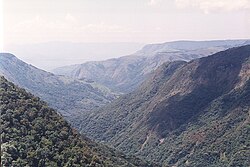Pungwe River
River in Zimbabwe and Mozambique From Wikipedia, the free encyclopedia
River in Zimbabwe and Mozambique From Wikipedia, the free encyclopedia
Pungwe River (Portuguese: Rio Púngoè or Rio Púnguè[5]) is a 400 km (250 mi) long river in Zimbabwe and Mozambique.[3][4] It rises below Mount Nyangani in the Eastern Highlands of Zimbabwe and then flows southeastwards through the Manica and Sofala provinces of Mozambique. The Pungwe enters the Urema Valley, the southernmost portion of the Great Rift Valley, where it forms the southern boundary of Gorongosa National Park. The Urema River joins it, and the river follows the rift valley southward. Large seasonal wetlands form around the Pungwe and Urema rivers in the rift valley section. It empties into the Mozambique Channel at Beira, forming a large estuary.[4] It is one of the major rivers of Mozambique and often causes floods.[3][4]



| Pungwe River | |
|---|---|
 Pungwe gorge in Nyanga National Park, Zimbabwe | |
 Map of the Pungwe River basin | |
| Native name | Rio Púngoè or Rio Púnguè (Portuguese) |
| Location | |
| Country | Zimbabwe and Mozambique |
| Physical characteristics | |
| Source | |
| • location | Mount Nyangani (Zimbabwe) |
| • elevation | 1,500 m (4,900 ft) |
| Mouth | |
• location | Beira, Indian Ocean |
• coordinates | 19.865278°S 34.818611°E |
• elevation | 0 m (0 ft) |
| Length | 400 km (250 mi) |
| Basin size | 31,151 km2 (12,027 sq mi) to 32,243.7 km2 (12,449.4 sq mi)[1] |
| Discharge | |
| • average | (Period: 1979–2015) 20.44 km3/a (648 m3/s)[2] (Period: 1971–2000) 615.9 m3/s (21,750 cu ft/s)[1] 120 m3/s (4,200 cu ft/s)[3] to 133 m3/s (4,700 cu ft/s)[4] |
| Basin features | |
| River system | Pungwe River |
| Tributaries | |
| • left | Vunduzi, Urema |
| • right | Honde |
| Waterfalls | Pungwe Falls |
The principal left tributaries are, from upstream to downstream, the Nhazonia, Txatola, Vinduzi, and Nhandugue-Urema. The right tributaries are the Honde and the Muda.
Administratively, the Pungwe Basin covers parts of Sofala and Manica provinces in Mozambique, and a large part of Mutasa District in Zimbabwe. A small portion of the basin in Zimbabwe falls in Nyanga District.[4] As of 2003, the basin's population in Mozambique is estimated at 1,104,000 people and that for Zimbabwe at 96,000 people.[4]
Beira metropolitan area in Mozambique receives its water supply from the Pungwe River. The 2004 water demand from the Beira/Dondo water supply, which included the Mutua and Mafambisse areas, was estimated at 25,339 cubic metres (894,800 cu ft)/day.
The city of Mutare is supplied from the Pungwe River through an inter-catchment transfer facility. The quantities transferred to are limited to a maximum of 0.7 cubic metres (25 cu ft)/second by the provisions of a water permit and system design. In addition, on 27 September 1995, it was agreed at a meeting of the Mozambican and Zimbabwean ministers responsible for water affairs that water could be abstracted from the Pungwe River to supply the city of Mutare, with an upper limit of 1 cubic metre (35 cu ft)/second. Consequently, a fixed abstraction of 60,480 cubic metres (2,136,000 cu ft) per day by Mutare city has been adopted as water demand from the Pungwe River. The Mutasa Rural District is also expected to draw water from the Pungwe pipeline to supply villages along its route.[4]
Climate change is predicted to lead to about 10% reduction in annual rainfall. This implies decreased river flow and available water for the Pungwe River basin, with possibly severe consequences for agricultural production. While the between-year variability in flow is not predicted to change significantly, within-year variability is expected to increase. This will worsen both floods and droughts.[3]
Discharge of the Pungwe River at Jangada (19°26′56.7276″S 34°32′16.2204″E). Period from 1998/01/01 to 2023/12/31 (Source: The Flood Observatory):[6]
| Year | Average discharge
(m3/s) |
Year | Average discharge
(m3/s) | ||||
|---|---|---|---|---|---|---|---|
| Mean | Min | Max | Mean | Min | Max | ||
| 1998 | 512 | 165 | 1,152 | 2011 | 496 | 219 | 861 |
| 1999 | 817 | 377 | 1,570 | 2012 | 196 | 28 | 553 |
| 2000 | 491 | 155 | 1,125 | 2013 | 471 | 108 | 1,068 |
| 2001 | 1,351 | 786 | 2,388 | 2014 | 565 | 199 | 991 |
| 2002 | 166 | 13 | 531 | 2015 | 263 | 53 | 683 |
| 2003 | 131 | 8 | 362 | 2016 | 329 | 86 | 730 |
| 2004 | 378 | 116 | 839 | 2017 | 798 | 304 | 1,772 |
| 2005 | 232 | 20 | 651 | 2018 | 800 | 298 | 1,453 |
| 2006 | 572 | 277 | 1,000 | 2019 | 1,010 | 297 | 2,237 |
| 2007 | 458 | 106 | 966 | 2020 | 647 | 165 | 1,315 |
| 2008 | 609 | 285 | 1,158 | 2021 | 884 | 381 | 1,863 |
| 2009 | 784 | 449 | 1,213 | 2022 | 524 | 164 | 1,224 |
| 2010 | 658 | 264 | 1,325 | 2023 | 718 | 237 | 1,463 |
Seamless Wikipedia browsing. On steroids.
Every time you click a link to Wikipedia, Wiktionary or Wikiquote in your browser's search results, it will show the modern Wikiwand interface.
Wikiwand extension is a five stars, simple, with minimum permission required to keep your browsing private, safe and transparent.